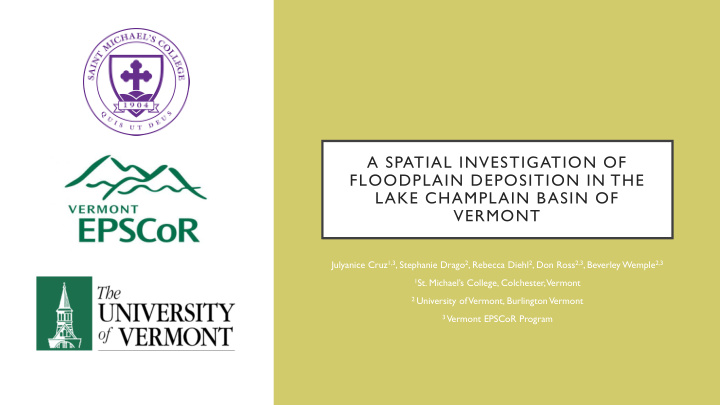



A SPATIAL INVESTIGATION OF FLOODPLAIN DEPOSITION IN THE LAKE CHAMPLAIN BASIN OF VERMONT Julyanice Cruz 1,3 , Stephanie Drago 2 , Rebecca Diehl 2 , Don Ross 2,3 , Beverley Wemple 2,3 1 St. Michael’s College, Colchester, Vermont 2 University of Vermont, Burlington Vermont 3 Vermont EPSCoR Program
EXTREME EVENTS • Vermont has long been prone to flooding and flood damage. Centuries of altering rivers by straightening and dredging them has caused many to become disconnected from their floodplains. • Irene left 11 inches of rain on parts of Vermont causing $14.3 billion damages. • Vermont’s River Management Program currently promoting new “Functioning Floodplain Initiative” to reconnect rivers to their floodplains. Sources: Vermont Official Website; Inside Climate News, 2016
WHAT IS A FLOOD PLAIN? • Periodic inundations physically modify lands near streams with every overflow. • Allows water to slow down, absorbs flood waters, and traps debris and organic material. • Cities, communities, and families living downstream of floodplains receive reduced flooding and improved water quality benefits from the ecosystem services that floodplains provide
OBJECTIVE • How much sediment and sediment bound phosphorus deposits on floodplains in Vermont? • Does the pattern of deposition on floodplains vary with distance to the stream? • Is there a difference in floodplain deposition between watersheds of the Lake Champlain basin and between land cover types on floodplains?
OBJECTIVE • Yellow stars indicate sites sampled; multiple samples were collected in a total of 12 sites. • Total of 81 samples collected and analyzed
FIELD METHODOLOGY Collected cores of 2019 spring floods deposits. Established plots to track flood deposition during summer of 2019. Each plot contains four patches of artificial grass. Each patch is located at a meter away from one another They are stapled to the ground to prevent them from getting caught in the water flow in case the streams overflow Sampling locations distributed through floodplains of different agricultural sites within the Lake Champlain basin of Vermont
LABORATORY METHODOLOGY Deposit Samples were sieved utilizing a 2mm sieve, then ground and passed through a second 0.5mm sieve. After sieving, between .5-.55g were measured from each sample and digested in a Microwave Accelerated Reaction System. Post digestion, samples were run through an ICP and Phosphorus content was measured.
RESULTS: BY WATERSHED
RESULTS: BY DISTANCE TO STREAM
RESULTS: BY LAND COVER
CONCLUSIONS • The studied floodplains demonstrate that they are efficient in trapping sediment and phosphorus. • Winooski had the thickest deposit and Missisquoi had the highest P concentration. • Deposit thickness and P content varied only slightly with distance to stream. • Sites sampled in forest and shrub land covers had thickest deposits, but P concentration of sampled deposits highest in wetland and hay land cover.
ACKNOWLEDGEMENTS • My Mentors: Beverly Wemple, Veronica Sosa-Gonzalez, Janel Roberge • Research Team: Rebecca Diehl, Stephanie Drago, Don Ross • The University of Vermont • Saint Michael’s College • Vermont EPSCoR Basin to Extreme Resilience (NSF OIA1556770)
QUESTIONS?
Recommend
More recommend